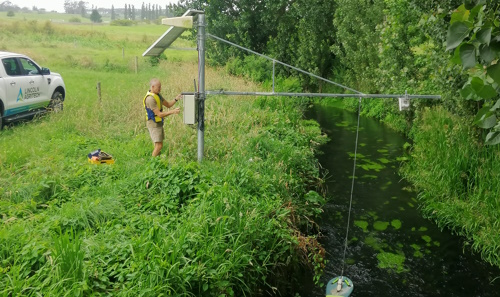
Lincoln Agritech Technician Brian Moorhead takes measurements at the Piakoiti Stream monitoring site.
Reducing nitrogen losses from farms is more cost-effective in areas with low natural nitrogen attenuation than in high-attenuation areas, according to a new report.
And in catchments with higher natural attenuation, groundwater targets could still be met with higher nitrate leaching than in lower-attenuation catchments – but more detail is needed to be certain about individual farms.
Agricultural economist Phil Journeaux prepared the report, “Economics of Attenuation Rates in the Piako and Waiotapu Catchments”, for Lincoln Agritech, at the end of its Critical Pathways programme.
The five-year programme investigated land-to-water nitrogen transfers, including nitrogen attenuation, in Waikato. It aimed to reveal the economic costs and benefits of identifying nitrogen attenuation rates.
Phil analysed data from 11 case-study farms (five in Piako, six in Waiotapu). Each farm was incorporated into Farmax, to model changes in farm systems, and OverseerFM, to estimate nitrogen losses from the root zone.
Nitrogen attenuation is the difference between the source nitrogen load at the root zone, estimated through OverseerFM, and the load measured at the stream monitoring zone (the delivered load).
Programme leader Roland Stenger explained that natural attenuation happens when micro-organisms convert nitrate (NO3) into gaseous forms of nitrogen. Most becomes environmentally benign dinitrogen (N2), while small amounts can also be converted into nitrous oxide (N2O), which is a greenhouse gas.
The Lincoln Agritech research team’s measurements and modelling suggested that just over half the nitrate (53% at Piako, 57% at Waiotapu) was naturally attenuated, when averaged over the entire catchment. However, the data could not provide certainty at sub-catchment or farm scale.
Absolute reduction
The analysis found that to get the same absolute reduction in the delivered nitrogen load, the source load had to be reduced more strongly in the higher-attenuation catchment than it did in the lower-attenuation catchment.
It also found that the cost per kilogram reduction in the delivered nitrogen load tended to be higher for less profitable farms – but this also depended on the nitrogen loading on the soil and the attenuation rate.
However, Phil said one vital piece of information was missing for a proper cost-benefit analysis of nitrogen attenuation. “Such an analysis also requires information on the benefit side,” he said. “While this could be generated, it was outside the scope of this project.”
Reducing the amount of nitrogen fertiliser would generally reduce nitrogen leaching and greenhouse gas emissions, the report said.
“However, the impact of mitigation on nitrogen leaching, greenhouse gas emissions and farm profitability varies substantially between farms,” said Phil. “There is no one recipe that works equally well across all farms.”
The Critical Pathways programme was funded by the Ministry of Business, Innovation & Employment.
You can read the full report here.


